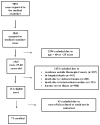Etiology of sudden death in the community: results of anatomical, metabolic, and genetic evaluation
- PMID: 20102864
- PMCID: PMC2905235
- DOI: 10.1016/j.ahj.2009.10.019
Etiology of sudden death in the community: results of anatomical, metabolic, and genetic evaluation
Abstract
Background: Identifying persons at risk for sudden cardiac death (SCD) is challenging. A comprehensive evaluation may reveal clues about the clinical, anatomical, genetic, and metabolic risk factors for SCD.
Methods: Seventy-one patients who had SCD (25-60 years old) without an initially apparent cause of death were evaluated at the Hennepin County Medical Examiner's office (Minneapolis, MN) from August 2001 to July 2004. We reviewed their clinic records conducted next-of-kin interviews and performed autopsy, laboratory testing, and genetic analysis for mutations in genes associated with the long QT syndrome.
Results: Mean age was 49.5 +/- 7 years, 86% were male, and 2 subjects had history of coronary heart disease (CHD). Coronary risk factors were highly prevalent in comparison to individuals of the same age group in this community (eg, smoking 61%, hypertension 27%, hyperlipidemia 25%) but inadequately treated. On autopsy, 80% of the subjects had high-grade coronary stenoses. Acute coronary lesions and previous silent myocardial infarction (MI) were found in 27% and 34%, respectively. Furthermore, 32% of the subjects had recently smoked cigarettes, and 50% had ingested analgesics. Possible deleterious mutations of the ion channel genes were detected in 5 subjects (7%). Of these, 4 were in the sodium channel gene SCN5A.
Conclusions: Most of the persons who had SCD in the community had severe subclinical CHD, including undetected previous MI. Traditional coronary risk factors were prevalent and undertreated. Mutations in the long QT syndrome genes were detected in a few subjects. These findings imply that improvements in the detection and treatment of subclinical CHD in the community are needed to prevent SCD.
Copyright 2010 Mosby, Inc. All rights reserved.
Figures
References
-
- Zheng Z, Croft JB, Giles WH, Mensah GA. Sudden Cardiac Death in the United States, 1989 to 1998. Circulation. 2001;104:2158–2163. - PubMed
-
- Huikuri HV, Castellanos A, Myerburg RJ. Sudden death due to cardiac arrhythmias. N Engl J Med. 2001;345:1473–1482. - PubMed
-
- Zipes DP, Wellens HJJ. Sudden Cardiac Death. Circulation. 1998;98:2334–2351. - PubMed
-
- Myerburg RJ, Kessler KM, Castellanos A. Sudden cardiac death: structure, function and time-dependence of risk. Circulation. 1992;85:I2–I10. - PubMed
-
- Kannel WB, Gagnon D, Cupples LA. Epidemiology of sudden coronary death: population at risk. Can J Cardiol. 1990;6:439–444. - PubMed
Publication types
MeSH terms
Grants and funding
LinkOut - more resources
Full Text Sources
Molecular Biology Databases
Miscellaneous


